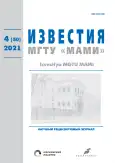Development of a complex of mathematical models of a vehicle suspension for fatigue life analysis
- Authors: Kulagin V.A.1
-
Affiliations:
- Central research and development automobile and engine institute NAMI
- Issue: Vol 15, No 4 (2021)
- Pages: 33-42
- Section: Original Study Articles
- URL: https://journals.rcsi.science/2074-0530/article/view/105607
- DOI: https://doi.org/10.31992/2074-0530-2021-50-4-33-42
- ID: 105607
Cite item
Full Text
Abstract
The reduction in the duration of the development of new vehicles and the associated desire to reduce the costs of automotive plants contribute to a more active application of mathematical modeling to solve engineering problems. The tasks, which are analyzing and predicting the fatigue life of vehicle components and assemblies, can be solved using a set of methods and tools of mathematical modeling.
This article discusses the development of a complex of mathematical models of the front and rear suspensions of a passenger automobile, which have the properties necessary for accurate reproduction of wheel loads and dynamic behavior of the suspension as a mechanical system. The complex of mathematical models is implemented in a multi-link modeling environment. The models are designed to carry out a subsequent validation study of the loading of individual suspension components during forced service life tests. In the future, this complex of mathematical models can be used for simulation of semi-natural forced resource tests of the suspension module, as well as a sample for the development of suspension models of other automobiles.
The purpose of this work is to form sufficient requirements for mathematical models for the implementation of fatigue durability studies using mathematical modeling methods and obtaining reliable calculation results. Research engineers will be able to follow these requirements to determine and collect initial data for the development of their own mathematical models.
Full Text
##article.viewOnOriginalSite##About the authors
V. A. Kulagin
Central research and development automobile and engine institute NAMI
Author for correspondence.
Email: viktor.kulagin@nami.ru
Russian Federation, Moscow
References
- Kulagin V.A., Bokarev A.I. Modern approaches of vehicle suspension durability evaluation at early stages of de-velopment // IOP Conf. Ser.: Mater. Sci. Eng. 2020. Vol. 941. No. 012072 doi: 10.1088/1757-899X/941/1/012072
- Adams: Real Dynamics for Functional Virtual Prototyping // MSC Software. URL: https://media.mscsoftware.com/cdn/farfuture/1w7MLM_qew4TQxvxo4njFVxKzznJ24sqjXq_dSz7LMo/mtime:1378846112/sites/default/files/ds_adams_ltr_w.pdf (data obrashcheniya 22.09.2021)
- GOST R 52051-2003 Power-driven vehicles and trailers. Classification and definitions. – Vved. 2004-01-01. Moscow: Standartinform Publ., 2008. 12 p.
- Blundell M., Harty D. The Multibody System Approach to Vehicle Dynamics. Ox.: Elsevier, 2015. 756 p.
- Kulagin V.A., Bokarev A.I. Investigation of the influence of the compliance of the components of the guide vane of the vehicle suspension on the accumulation of damage in modeling the load cycle of life tests. Sbornik «Forum innovatsionnykh transportnykh tekhnologiy, nazemn·yye intellektual'n·yye transportn·yye sredstva i sistemY». Ob"yedinеnnyy mezhdunarodnyy onlayn forum [Collection “Forum of innovative transport technologies, ground intelli-gent vehicles and systems”. United international online forum]. 2020, pp. 1165−1190 (in Russ.).
- Johannesson P., Speckert M. Guide to Load Analysis for Durability in Vehicle Engineering. Ch.: Wiley, 2014. 458 p.
- Scheiblegger Ch., Lin J., Karrer H. New Nonlinear Bushing Model for Ride Comfort and Handling Simulation: Focusing on Linearization and the Implementation into MBS Environment // Proc. FISITA 2012 Wor. Auto. Con., Vol. 10. Be.: Springer, 2013. P 461−473. doi: 10.1007/978-3-642-33795-6_38
Supplementary files
















